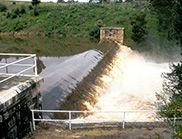Greenhouse warming increases frequency of devastating La Niña events
“The frequency of extreme La Niña events is projected to increase from one event in 23 years over the 1900-1999 period to one event in 13 years in the 2000-2099 period,” lead author Dr Wenju Cai of CSIRO said.
Importantly, 75 per cent of the projected increase of extreme La Niña events occurs after an extreme El Niño, the opposite state of La Niña, which causes droughts in eastern Australia.
“The latest climate models are projecting more-frequent swings between opposite extremes from one year to the next,” co-author and CSIRO postdoctoral fellow, Dr Guojian Wang said.
La Niña events, a climate state of the equatorial Pacific Ocean, in which the western Pacific rain band intensifies and moves towards Australia, are often linked to extreme weather events within the Pacific Rim region.
“The 1998 extreme La Niña, the strongest in the 20th century, caused disastrous extreme weather in many parts of the world,” Dr Cai said.
The frequency of extreme La Niña events is projected to increase from one event in 23 years over the 1900-1999 period to one event in 13 years in the 2000-2099 period”
Dr Wenju Cai
“South-western United States experienced severe drought, Bangladesh experienced one of the most destructive flooding events in modern history, with over 50 per cent of the country’s land flooded, and in China floods and storms displaced over 200 million people.
“The 1998 North Atlantic hurricane season saw one of the deadliest and strongest hurricanes (Mitch) in the historical record, claiming more than 11 000 lives.”
To investigate how such events may change under a changing climate, the study used 21 climate models that participated in the Intergovernmental Panel on Climate Change (IPCC) Fifth Assessment Report.
The ensemble of models is able to simulate extreme La Niña and extreme El Niño events, and there is a significant increase in the number of extreme La Niñas with a strong inter-model consensus.
This study, and a sister paper Response of El Niño sea surface temperature variability to greenhouse warming published in Nature Climate Change last year, found that under the business-as-usual greenhouse gas emission scenario, the frequency of both extreme El Niño and extreme La Niña increases.
Extreme El Niño generates an ocean response that is favourable for an extreme La Niña to follow. The favourable condition is enhanced by a faster warming rate over the Maritime region than in the central Pacific.
Media resources
Click image for high resolution version

